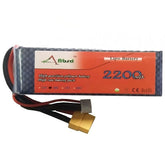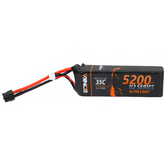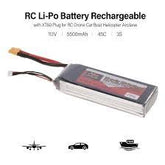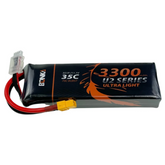All About Lithium Polymer Batteries (LiPo)
Summary
Explore the world of Lithium Polymer Batteries (LiPo) in our comprehensive blog! We kick things off with an introduction to LiPo batteries, delving into their composition and functionality. Discover the numerous advantages that make LiPo batteries a popular choice in various industries. Uncover the wide range of applications where LiPo batteries shine, from RC hobbyists to aerospace technology. Learn how to decipher LiPo battery ratings and make the right choice for your specific needs. Dive into the crucial aspects of LiPo battery health and longevity, along with essential safety considerations. Finally, don't miss our conclusion, wrapping up the power-packed world of LiPo batteries. Click now to empower your knowledge!
Introduction
Lithium-polymer (LiPo) batteries are a type of rechargeable battery that offers very high energy densities and lightweight for many industries, including consumer electronics, medical devices, aerospace applications and more. They provide an excellent balance between power output rate and capacity over traditional lithium batteries. LiPo technology has far surpassed other types of chemical counterparts in both physical size-to-usage ratios as well as cost-effectiveness - all important considerations when building or designing tech products today. What's more is the flexibility they offer designers since each cell has its own working voltage making them modular; something not found with older technologies like Nickel Cadmium or Lead Acid Batteries due to their lower single voltages being set static across many cells/battery configurations.
What is a LiPo Battery

LiPo batteries are very popular batteries when talking about rechargeable batteries, as they are capable of powering up RCs and Quadcopters in a much better way than any other Rechargeable batteries like AAA, Nickel Cadmium, etc.
Lithium Polymer Batteries or LiPo batteries use a polymer electrolyte inside them instead of using a liquid electrolyte hence the name Lithium Polymer. These Batteries are volatile and come in different shapes and sizes depending on the cells inside them. These batteries can provide high output power and are used in applications where weight is a critical feature for operation for eg. Mobile devices like drones, RC cars, etc.
read more : Affordable Drone Batteries
Advantages of LiPo Batteries
- LiPo batteries are considerably lighter than other types of rechargeable battery, making them ideal for use in applications where weight is an important factor.
- They have a much higher energy density that makes them perfect for powering high-performance electronics such as drones and RC vehicles which require lots of power with minimal size or mass restrictions.
- Due to their low self-discharge rate, they can be stored without losing charge over long periods — up to one year if kept at the right temperature range and unprotected against physical damage or extreme temperatures.
- Thanks to built-in safety features like integrated protection circuitry (PCBs), they’re considered amongst the safest batteries available on the market today—and can even prevent users from shorting out circuits by mistake when connecting/disconnecting cables incorrectly!
- LiPo cells possess a good cycle life meaning you get plenty of runs before needing to replace your cell; this coupled with having no memory effect means you always keep optimum performance regardless of how often your battery gets used during its lifespan!
- Their charging times are also unbeatably fast compared to traditional NiMh models; allowing users to save time that could otherwise wasted waiting around while their device charges up again after being depleted completely mid-run!.
read more : Upgrade Your Control: Best Drone Remote Controllers
Applications of LiPo Batteries
- LiPo batteries are often used in consumer electronics such as laptops, tablets, and phones because they offer higher energy density than other battery types.
- Drones rely on lightweight lithium-polymer (LiPo) batteries for power due to their high current delivery capability and long run times when compared to other alternatives like NiCd or nickel metal hydride cells.
- Cordless tools generally use LiPos since they can provide the sustained torque necessary while lasting significantly longer between charges with no memory effect thanks to their cell chemistry composition design features.
- Many RC hobbies also benefit from using Lithium Polymers instead of conventional lead acid cells because these packs contain up to two to three times more charge per weight ratio which helps them maintain a steady flight time even under harsh conditions where vibration is present or extreme temperatures occur that would otherwise disrupt operation potentials from traditional designs.
- Electric vehicles commonly employ Lipo Batteries for powering EVs due to their superior storage capacity yet low-temperature image staircase effects allowing greater range without fear of overcharging damages unlike Nickel Chemistries could suffer making it an ideal choice within this application segment variable ranges available based upon component size requirements versus pack capacities desired by customer needs.
- High acoustic audio performance systems requiring mobility utilize rechargeable lipo batteries providing needed audible clarity along durable portability that’s not inhibited by any cooling prerequisites normally associated with most combustion engines needing detection fan assistance mechanisms adding additional cost burdens anticipated.
read more : How to fly a quadcopter
Also, read our blog on Li-po vs Li-ion Battery detailing comparison based on their specification, advantages, and disadvantages.
Ratings of the LiPo Battery:

read more : Introduction to Lithium Ion Batteries and its Applications
LiPo Batteries have certain ratings on the pack that are vital to an understanding before buying.
There is an “S” rating or the series rating on the batteries that symbolizes, the total number of cells wrapped insides a single battery. So if there is a battery with a rating of 2S it means that it has two cells wrapped inside it. The nominal voltage that 1 cell provides is almost 3.7 volts, so if you have a 3S-rated battery that means it will have a voltage rating of 11.1V or vice versa in the case of the battery shown above. The above figure has specified the rating as 11.1 V that means it has 3 cells rapped in it. Mostly all RC cars and Drones use 3S to 4S LiPo batteries.
The mAh rating is short for milliamps hour, this rating tells you roughly how long will the LiPo Battery Last, how much “juice” it has. It is a unit that tells us about the capacity of the battery, the higher the number, the more energy the battery can store and the more longer it can run
The “C” rating is the maximum safe continuous discharge rate, in the above image the battery is rated 25c it means that the current I can draw safely from the battery without damaging or overheating it is: 25 * 54000 mA = 135 Ampere of current can be drawn from the battery continuously for 1 hour safely without damaging it. So you can rotors at full throttle or can make your drone fly acrobatically using that much current.
read more : How to make quadcopter using Arduino
How to Choose a LiPo Battery for your Application:
When you are choosing a LiPo battery for your project or application you need to go through the Ratings that are mentioned above that is:
- The Series Rating
- The mAh rating or Ah rating
- The C Rating
Now addition to these three ratings, there is also a Discharge rating which is also measured in “C” which is when you multiply the mAh rating with this discharge rating you will get the amount of current that gets discharged from the battery continuously in one hour.
Now when you are selecting a LiPo you need to also ensure the connectors that the battery comes up with and whether your LiPo charger is capable of Charging the battery that way.
Lastly, the cost factor comes in, which is not the primary concern, because to need the best for your application you need to spend a hefty amount on the battery, but if you need to cut the cost on batteries, you need to compromise on the project’s Performance.
read more : How to build a quadcopter drone at home
LiPo battery chargers and charging.
Typically the battery Chargers that come with LiPo batteries are 80 W 6 A chargers that can charge 6S batteries these chargers have built monitors on them that show the state of the battery voltage while charging, thus you can use that to plug out the charger to avoid overcharging the battery, also it is advisable to ensure that the battery is not discharged below 20% of its total capacity to avoid it from swelling up, overheating and catching fire or being damaged.
While charging the battery you should always be present near the battery, you should never charge a damaged battery or swollen up battery. You should also ensure that the battery is charging at a low charging rate of up to 1C if you vary the charging rate on your charger. A slower charging rate ensures the good stability of the battery.
If your battery charger does not have a screen to display the voltage levels of cells while charging then you can use a Battery Monitor that tells you the same and even buzzes alarms to let you know about overcharging.
Ensure to always use a balance connector while charging the battery to ensure that the voltage in each cell while charging the battery is balanced or equal, this avoids unnecessary damages to the LiPo.
read more : Drone Motor – Where to Begin?
LiPo Battery health and Lifetime:
The LiPo battery life is fairly nice, but it does not depend on its usage. Typically a LiPo battery works well enough till 300 charge cycles.
To maintain the good health of the Battery you need to ensure a few things:
- Never Discharge your LiPo Battery at a rate more than what it can handle it will make the LiPo swell and might damage its functioning.
- Never Charge a LiPo that is warm from usage or never use a LiPo that is warm from Charging.
- Overcharging your LiPo will not make it increase its energy capacity but only deteriorate it.
- If you are not using the LiPo battery for a couple of days, do not keep it charged, you should discharge it and store it properly. Discharge it to a voltage of 3.7 V per cell.
- When you discharge a LiPo battery do not bring the per-cell voltage level below 3V, this may damage the LiPo’s Health. Keep the Voltage ideally to 3.6 -3.7V per cell.
read more : Drone Transmitter and Receiver Guide
Safety Considerations of LiPo Batteries
- Always charge and store LiPo batteries in a fire-proof container that is well-ventilated to avoid overheating or combustion.
- Never connect two LiPos together for charging because this can cause high current flow which may ignite the battery and result in an explosion.
- Use only compatible chargers with your specific model of lithium polymer rechargeable cell, as using an incompatible one could be dangerous due to mismatched voltage settings on some models (charging at incorrect output levels).
- Ensure the charger’s power input does not exceed the manufacturer's recommended maximum watts/amps; if so, it will lead to overloading of cells – again potentially causing explosions when they are being recharged next time around!
- Be sure all connections between components such as wires & connectors are secure before you use them - loose links here can create heat build-up that leads to irreversible damage done too easily from careless mistakes made during wiring setups
- Take regular breaks while charging these packs often enough periodically check their temperature before continuing usage
- If any smell or smoke occurs while working near/with these lipo battery packs then stop immediately, unplugging all cords associated with its setup
- Once finished always disconnect firstly from power source followed by other cable accessories
- Charge NiCad systems slowly (trickle charges) instead of fast(conventional methods); resulting lower temp ensures longer life span overall.
read more : Best Flight Controller for Drone
Conclusion:
we've taken a deep dive into the world of Lithium Polymer batteries (LiPo). From understanding their composition and advantages to exploring their diverse applications and important ratings, we've equipped you with the knowledge to make informed choices. Choosing the right LiPo battery and ensuring its health and longevity are crucial for efficiency and safety. Remember, a reliable LiPo battery charger is your best companion. Lastly, safety should always be a top priority when dealing with LiPo batteries. With the right precautions, LiPo batteries can power our gadgets and projects efficiently and safely. Stay charged and stay safe! Ready to power up your next adventure? Click the link below for more exciting battery insights!
If you appreciate our work don't forget to share this post and leave your opinion in the comment box.
Please do check out other blog posts about Popular electronics
Make sure you check out our wide range of products and collections (we offer some exciting deals!)












